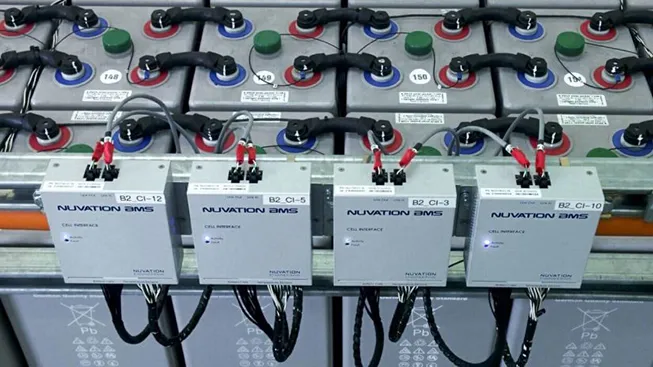September 18, 2019
Battery Management for Large-Scale Energy Storage (Part 3)
Part 3 of 4:
- Protecting the Battery
- Warnings, Faults, & User-Defined Thresholds
- Communicating with Energy Controllers
- Power Conversion Systems (PCS)
- Energy Controllers
- Environmental Controls
- Cell Balancing
Protecting the Battery
Warnings, Faults, & User-Defined Thresholds
Nuvation Energy’s battery management system provides two levels of response when a battery is moving out of its nominal operating parameters. As cell temperature, current, and voltage drift outside of (i.e. above or below) nominal parameters, the battery management system will generate a ‘Warning’ to the human user and/or to automated control systems in the battery pack, alerting them that although the battery is still operating within safe parameters, it is getting too close to the edges of those thresholds. A Warning notification can trigger preventive actions that could potentially resolve the issue without requiring the battery to be taken offline. In a situation where the safety thresholds have been passed, the BMS will trigger a ‘Fault’ message and open the contactors to disconnect the battery from the power path.
Nuvation Energy’s battery management system also enables the implementation of user-defined thresholds that can trigger responses from the PCS and other devices in the energy storage system. User-defined thresholds reside within the safe operating ranges of the battery and can accommodate system-level performance requirements or trigger actions that ensure the battery never exceeds safety parameters. For example, a user-defined temperature threshold can activate cooling fans in the battery rack before the batteries begin to overheat. If the battery temperature continues to rise after the cooling fans have been activated, a slightly higher temperature threshold can initiate a reduction in current from the PCS. All these actions can be initiated while the battery is well within nominal operating parameters, to ensure that it does not exceed them.

Figure 1 is a screen capture of Nuvation Energy’s battery management system managing a Nuvation-designed 2MW / 588 kWh energy storage system. A user-defined threshold of a minimum stack voltage of 720 V has been programmed into the BMS, because the PCS requires this minimum stack voltage for proper operation. To maintain the power levels required by the PCS, ‘0% SoC’ has been configured in the BMS to be 720 Volts, as opposed to the minimum SoC required to protect the battery. In this screenshot taken during system testing before commissioning, we see that a Warning has been generated by the BMS due to the low stack voltage, and the SoC gauge reads 0%. The cell voltage and temperature gauges, however, clearly show that the battery cells are within nominal operating parameters and not at risk. If the Stack voltage drops further, the BMS will disconnect the stack from the DC bus in the ESS because the battery stack will no longer be generating the minimum voltage required by the PCS.
User-defined thresholds can also initiate communications with system maintenance personnel. An energy management system or PLC device can alert ESS management staff, trigger a service call, or initiate an emergency response via e-mail, text message, or through the control panel of a building management system.

Communicating with Energy Controllers
Power Conversion Systems (PCS)
The sharing of data between the PCS and BMS can be challenging when integrating proprietary communications protocols across the two products. Fortunately the energy storage industry as a whole is moving towards the standardization of communications protocols. If you are in the market for a battery management system for your ESS, it would be prudent to ask if it utilizes open or proprietary communications protocols, and to understand the level of effort that will be required for system integration. Nuvation’s battery management system uses the open MESA protocol to enable the sharing of sensor data received by the BMS. This enables the PCS to control with more precision the charge it is delivering to or drawing from the batteries, and improves the PCS’ effectiveness at regulating current for the purpose of thermal management.
Energy Controllers
Control systems that manage energy storage applications such as PV smoothing, frequency regulation, and demand charge management are dependent on data from the battery management system regarding the level of charge available in the battery packs, as well as the amount of energy available in the ESS. For example, if the BMS disconnects a battery stack for servicing or safety reasons, this reduces the amount of available energy that the ESS can provide. If that energy reduction is not communicated to the controllers that are executing the energy storage application, those systems may erroneously assume that a higher amount of energy is available. That omission in data reporting could result in a sudden and unexpected loss of power during ESS operation.
The MESA protocol was designed for integration with other protocols used at successively higher levels in the energy storage system architecture, up to the utility-grid energy management level (i.e. DNP3). This greatly simplifies the sharing of battery data with higher-level energy controllers.
Environmental Controls
Environmental controls protect battery cells from damage by regulating ambient temperature to prevent the batteries from getting too cold or too hot. Where communications exist between the BMS and HVAC system, environmental controls can activate based on battery module temperature data provided by the BMS, as opposed to ambient room temperature readings, which would be received only after sufficient heat had built up inside the modules to impact the room temperature.
In environmental control scenarios, real-time access to temperature data from the BMS can make the difference between the initiation of preventive actions and the management of a catastrophic event after the fact. For this reason Nuvation’s Grid Battery Controller is designed to be able to communicate with up to 16 external devices at the same time. These can include HVAC systems, PLCs, SCADA, energy management systems, control station interfaces, etc.
Cell Balancing
Cell balancing refers to the process of maintaining an equivalent amount of charge in all series-connected cells. Balancing ensures that all cells in each battery module get fully charged and none are overcharged in the process. Many battery chemistries require cell balancing from the BMS during the charge cycle. One exception is that some lead-acid batteries ensure that all cells reach full charge through a periodic calibration process called equalization, which involves overcharging the stronger cell while other cells catch up.
Nuvation Energy’s battery management system performs cell balancing by diverting energy from the cells that are charging faster than others. This enables all cells to charge at a fairly uniform rate until full. Since battery cells in a module are usually very closely matched in terms of the rate at which they charge, very little energy is wasted in this process. If one cell has a very different impedance from other cells (i.e. it is charging at a significantly slower or faster rate than the other cells), that battery module is generally considered to be damaged and is replaced as part of regular ESS maintenance.
Up Next
- State of Charge (SoC) and Depth of Discharge (DoD)
- How are SoC and DoD Measured by the BMS?
- Lead Acid Batteries and Battery Management
- Optimizing for Cycle Count
- Conclusion

